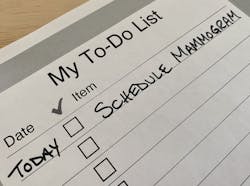Having the ability to self-schedule mammograms was associated with a 15 percentage point increase following through with getting the screening, according to research from the Perelman School of Medicine at the University of Pennsylvania. The paper was published in the American Journal of Preventive Medicine.
For their study, lead author, Kimberly Waddell, PhD, MSCI, an assistant professor of Physical Medicine and Rehabilitation, and senior author Shivan Mehta, MD, MBA, an associate professor of Gastroenterology and the associate chief innovation officer of Penn Medicine, along with their colleagues, analyzed data from 2016-2019 when the University of Pennsylvania Health System opened up the opportunity for patients to schedule their own mammograms through their personal online patient portals and compared it to data from 2014 until 2016, before this was possible. To schedule their mammograms, all patients needed was an order—initiated after seeing their primary care provider—and to log in to the patient portal and click through to a scheduling link. They also received a reminder e-mail message to self-schedule through their portal.
Before this, patients referred for mammograms received no reminders and had to make calls during regular business hours to schedule. By using the behavioral science concept of “nudging,” which entails making small changes that make it easier and more likely for people to accomplish the desired task, the health system was able to encourage completion of what could have previously served as a barrier to screening.
Data from roughly 35,000 patient visits showed that, overall, mammogram completions roughly doubled over the study period, going from approximately 22 percent to 50. Within that, the self-scheduling was directly associated with an approximate 13 percentage point increase in screening completions, according to the researchers. At scale, when applied to the 35,000 patients in the study, that translates to roughly 4,500 more people getting screened.
Among those who were specifically active in their online patient portals—meaning they’d logged into the portal at least once in the previous year—the self-scheduling intervention was associated with a 13 percentage point increase in screenings compared to those who didn’t use their patient portal previously.
Perelman School of Medicine at the University of Pennsylvania release on Newswise

